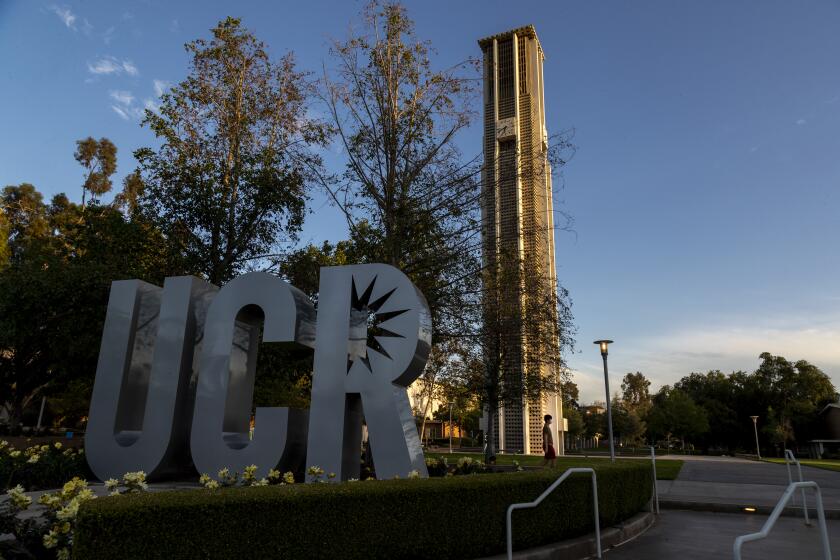A Media Mouse That Roared
When Mike Lacey, owner of the New Times newspaper chain, sat down with the editorial staff of New Times Los Angeles three weeks ago and told us he had the worst possible news for us all, my first thought was, “Oh, no, Lacey has cancer.”
With only 20 full-time writers, editors, photographers and other editorial employees, New Times was a full-throated, outsized voice in a tremendously meek media town. Many of us saw our noisy weekly paper as indispensable to the battle over how to shape this troubled city -- and we felt invincible because of it.
New Times writers like Michael Gougis, Susan Goldsmith, Tony Ortega, Ron Russell, Rick Barrs and others were raking in big journalism awards that often went to major dailies. Talk shows and Hollywood agents were clamoring for access to our investigative revelations. Most important, we were hated by all the right people.
But there was also that other thing: red ink.
After Sept. 11, advertising sales dropped off dramatically as cautious national advertisers cut back and never re-upped. Since the newspaper was free to readers, advertising was all there was to support the operation. So New Times came to an agreement with Village Voice Media, which owns the LA Weekly: Village Voice Media would pay New Times an undisclosed sum and fold its paper in Cleveland, where it competes with a New Times paper, and New Times would fold its paper here.
I look out on the media landscape of Los Angeles and I mourn not merely the passing of a great, gutsy newspaper but also the state of the media in the country’s second-largest city. The New Times chain puts out the only alternative weeklies that hit the news harder with each passing year. Other alternative newspapers have become increasingly soft and mired in out-of-touch 1970s-era liberal Democratic mantras. The Village Voice rarely breaks or illuminates the news anymore. And the paper controlled locally by the Voice, rightly dubbed the “L.A. Weakly,” frets so about hewing to ancient leftist cant that it is incapable of pursuing most of the juicy and endless stories that offend black liberals, Latino liberals, laboristas, feministas and the like.
New Times reveled in offending those liberal interest groups, whose power far outstrips their numbers. But it wasn’t merely that we delighted in annoying people -- although we did love that fringe benefit. No, we were engaged in a crucial business. We were trying to put an end to outrageous assumptions and activities that we believed were helping drive L.A. into the ground.
And we did it, time and again. New Times staff meetings often touched on how the local media were not plundering the amazing riches of controversies here, and might just as well have been covering Des Moines. Investigative reporter Goldsmith wrote bravely about tough racial truths in her cover story “Blacks Only,” which reported on overt racism practiced against nonblack doctors by the black power elite who run King-Drew Medical Center. Her investigation into indefensible practices by L.A. County workers to prevent interracial adoptions won her the Casey Medal for Meritorious Journalism, but the story died on the local 11 o’clock news.
The media in Los Angeles for years missed the story of pedophile priests who betrayed both their faith and their followers. But when it finally started to come out, our reporter Russell did, for my money, the best job of explaining how Cardinal Roger Mahony had for years deviously covered up for these priests and allowed them to continue working around children. Russell won the Silver Medallion from the California Bar Assn. for his probe into the Mexican Mafia. When New Times closed its doors, Russell was working on yet another disturbing Mahony piece that everyone should have read.
I like to think that my columns, in which I regularly exposed educational malpractice within the Los Angeles Unified School District (or L.A. Mummified, as I called it), played a role in persuading voters to oust a shameful school board controlled by a teachers union that cared only about pay. The new reformist board has dramatically raised reading ability among inner-city and immigrant grade-schoolers -- practically a modern miracle -- due in no small part to the abandonment of those twin anathemas of education: whole-language reading instruction and bilingual education.
New Times circulation had reached about 115,000 when it ceased publication, so most of the 3.65 million Angelenos never saw our coverage. Much of our power to influence these debates derived from the fact that we were widely read by print, radio, online and TV journalists. We took credit for educating those reporters to meatier news in a town that was drowning in journalistic pablum.
We became known as an institution that refused to behave itself. We took on the sacred cows, like multimillionaire developer Danny Bakewell, state Assemblywoman Jackie Goldberg (D-Los Angeles), state Sen. Kevin Murray (D-Culver City), Mahony, L.A. County Supervisor Gloria Molina and the whole crew of cookie-cutter elected liberal Democrats who control the L.A. City Council and legislative seats in Sacramento.
It was interesting to watch people’s reactions. Some hated us, prayed for us to disappear. Others, although certainly not happy with our coverage of them, came to like New Times because it skewered their enemies, too. We were equal-opportunity lambasters. We just wanted to force crucial issues into the open, to keep our massive region from devolving into a West Coast urban nightmare a la Detroit.
When the Daily News wrote of New Times’ end, it quoted former Mayor Richard Riordan, who called it “a horrible event.” Even more surprising to some, he praised editor Rick Barrs’ column, The Finger -- even though it had regularly attacked Riordan as a weak mayor controlled by puppeteers, dubbing him Mayor Howdy Doody. He was right to praise The Finger, the column that broke, among many other things, news of the Los Angeles Times’ unethical production of a magazine about Staples Center in which profits generated by the magazine were shared with Staples Center. “I felt The Finger’s finger many times,” Riordan told the Daily News. “I thought The Finger was right on, didn’t respect anybody.”
That was almost, but not entirely, true of all of us at New Times. Lacey hired us six years ago with the promise that if we unearthed uncomfortable truths, he would print them. He granted us incredible freedom. But some members of the power elite won our respect. A handful told the truth, fought hard to make the world a better place and rarely acted merely for themselves. They included school board member David Tokofsky, former state legislator Tom Hayden and even the bumbling but popular Riordan (who once excitedly approached Barrs at a party, offered up a dramatic handshake and loudly cried out, “Howdy!”).
Riordan keeps threatening to launch his own weekly newspaper. He has, full disclosure requires me to reveal, raised the possibility of my being involved if he goes forward. I don’t know, in the end, what I’ll do next, but I certainly agree with one thing Riordan recently told me: “L.A. needs a paper that is controversial and gets people mad and talking about people and power. New York has several like that. But now, Los Angeles has none.”
The Daily News comes closest but is confined to the San Fernando Valley and needs a much bigger staff if it is ever to consistently go after in-depth issues. Besides my devotion to on-target Daily News City Hall reporter Rick Orlov and the courageous Larry Elder on KABC-AM radio, I now look to a precious few insightful TV reporters like Channel 2’s Joel Grover, Channel 11’s John Schwada and Channel 9’s Dave Bryan to give us the quick and dirty on what is really happening in this lushly complicated society we call Los Angeles.
It shouldn’t be this way in the second-largest media market in the country. I am looking out at this desert of a media landscape, and I am praying for rain.
More to Read
Start your day right
Sign up for Essential California for news, features and recommendations from the L.A. Times and beyond in your inbox six days a week.
You may occasionally receive promotional content from the Los Angeles Times.





